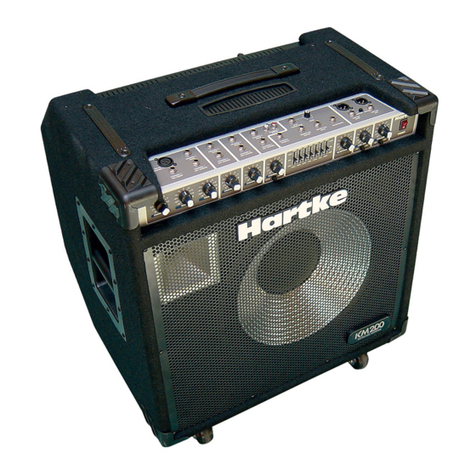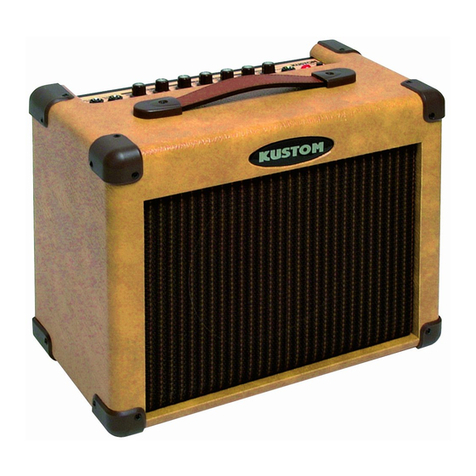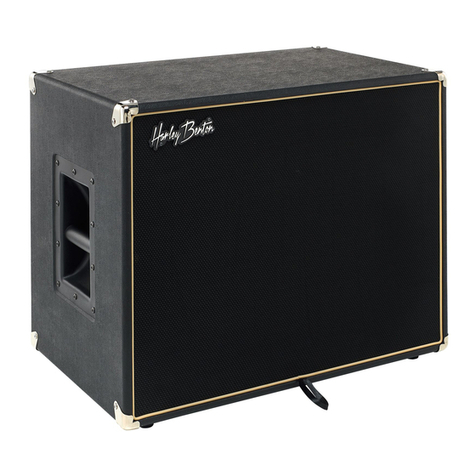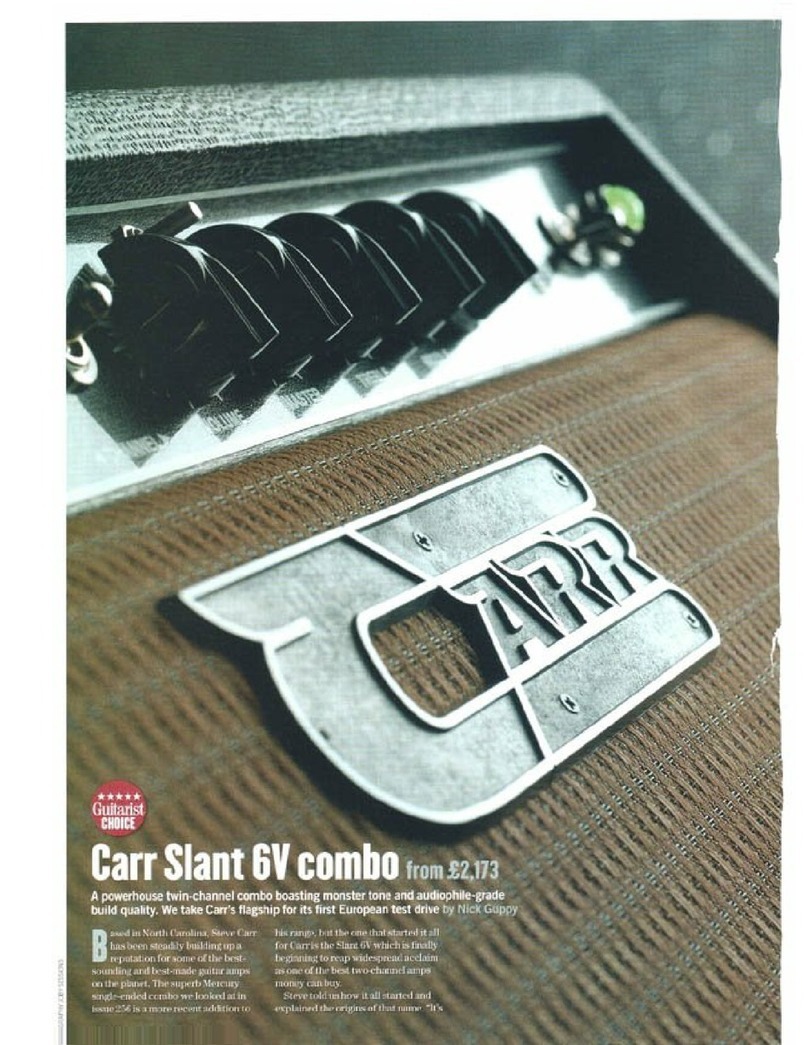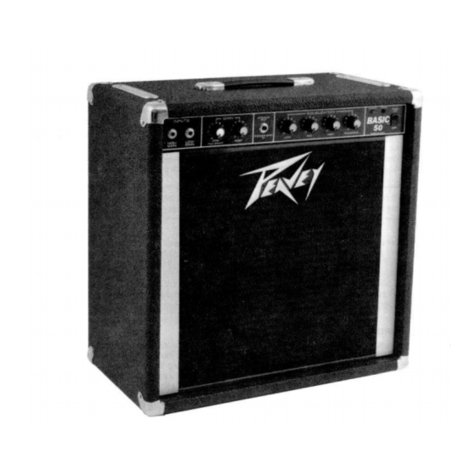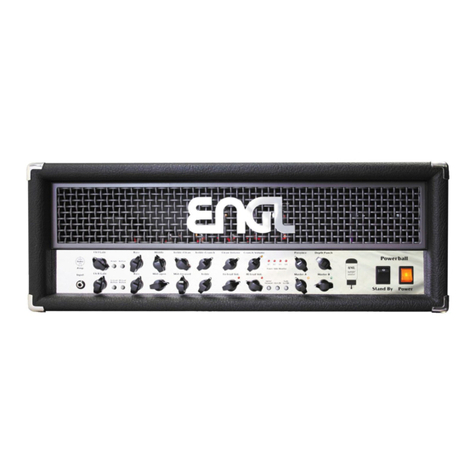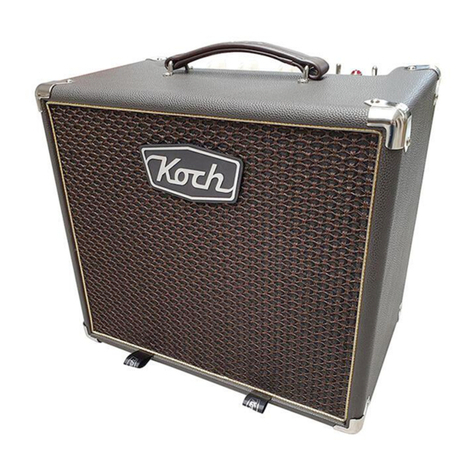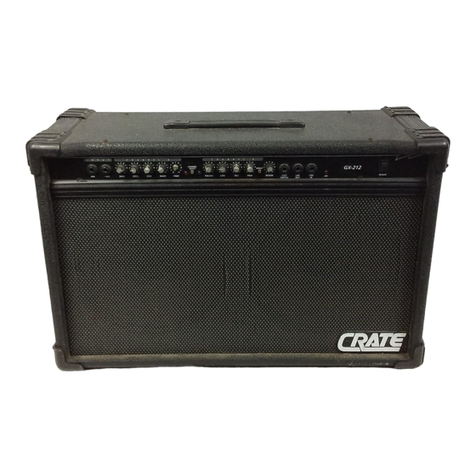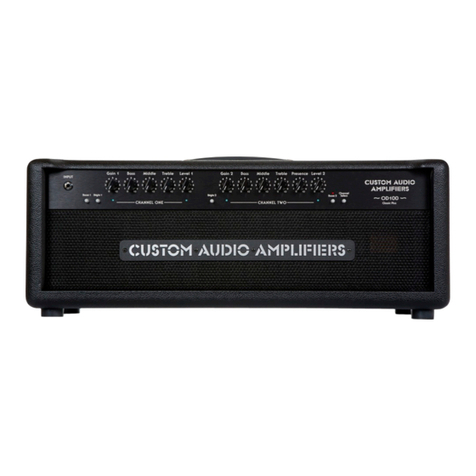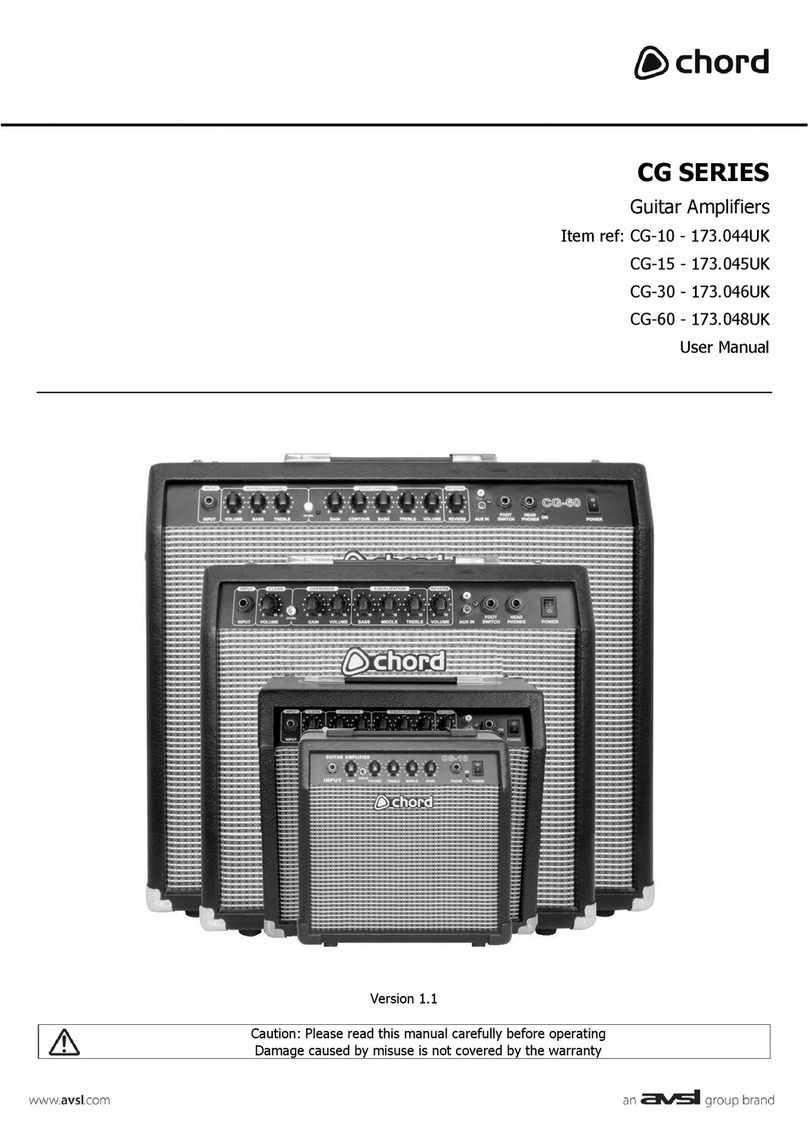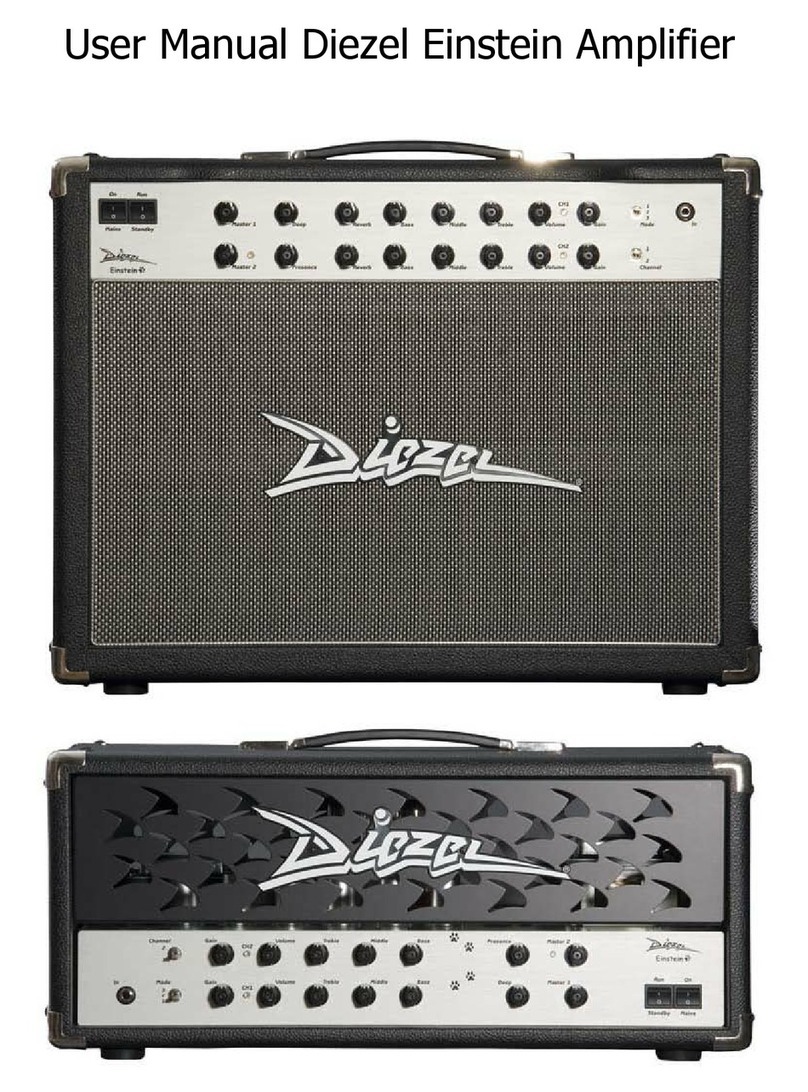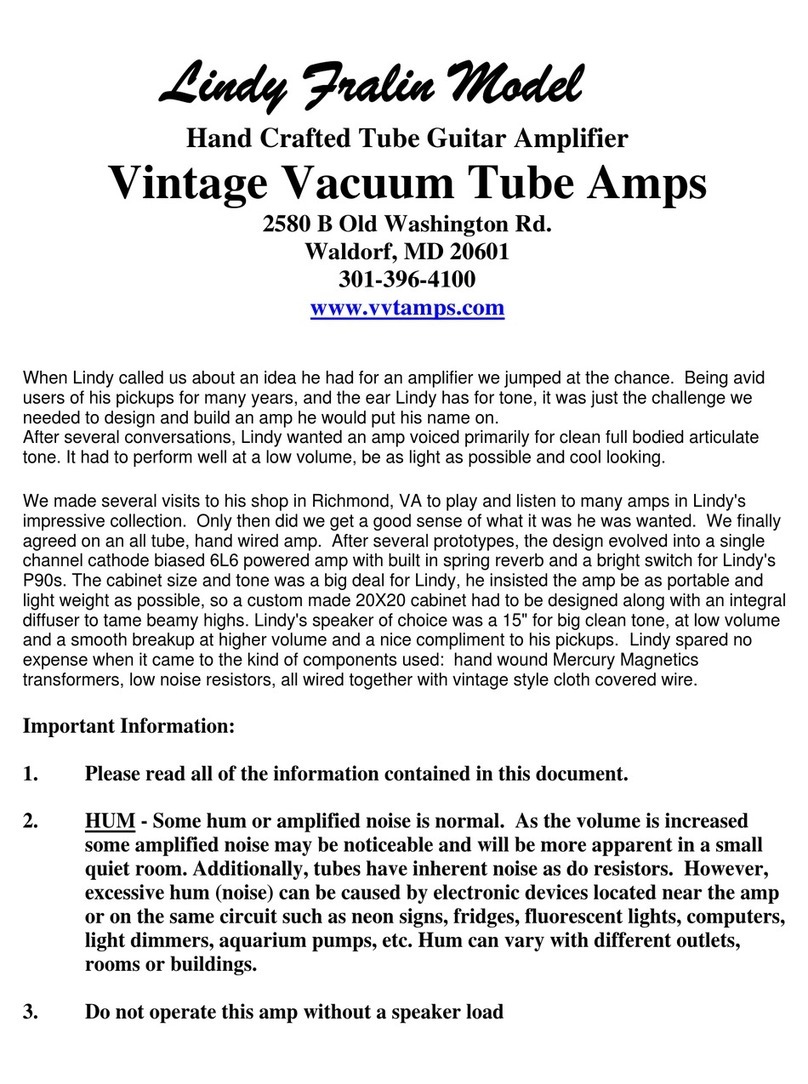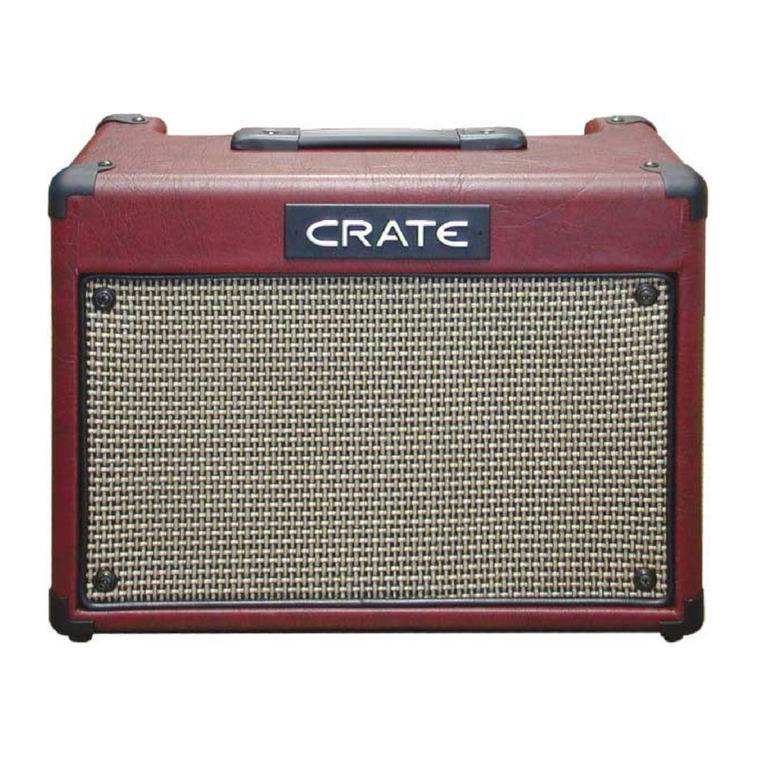Elmwood STINGER 30 User manual

STINGER – Owner’s Manual – Ver: 2.31 1 Elmwood Amps
S T I N G E R 3 0
Owner’s Manual

STINGER – Owner’s Manual – Ver: 2.31 2 Elmwood Amps
CONTENT
Content
Welcome …………………………………………….. 3
Precautions …………………………………………….. 4
Introduction …………………………………………….. 5
Getting started …………………………………………….. 6
Channel 1 & 2 …………………………………………….. 8
Toggle switches and Hi Cut Knob ……………………….. 8
FX Loop / Solo Boost …………………………………………….. 9
Back panel …………………………………………….. 10
Tubes maintenance …………………………………………….. 12
Specifications …………………………………………….. 14
Contact …………………………………………….. 15

STINGER – Owner’s Manual – Ver: 2.31 3 Elmwood Amps
WELCOME
Congratulations
to your purchase of a Elmwood STINGER.
The STINGER is a 30 watt cathode biased EL84 equipped amplifier with separate
Gain and Volume for the 2 channels.
Among many smart features the power amp can be switched between Modern style
and Vintage style and the FX loop can be altered as a solo booster. The traditional
EQ puts you right in control. Equipped also with a three position bright switch and a
Hi cut knob.
The Stinger is capable of producing everything from big warm clean sounds and
funky clean rhythm to raw crunch and singing lead tones with its own touch.
Features
•The STINGER is a 2 channel, all tube amplifier
•Each channel has its own Gain and Volume controls as well as a three position
bright switch.
•The two channels are footswitch able.
•The EQ section contains Treble, Middle, Bass and High cut.
•There are two different output power modes; Modern and Vintage.
Modern is full output, 30 watts
Vintage lowers the output to approximately 18 watts and gives the
amplifier a somewhat darker voicing and a smoother feel.
•Serial FX loop with an adjustable send level that also can act as a volume
booster using the footswitch’s on/off feature.
•The amplifier chassis is built as a 2 unit high, rack mountable unit and is fan
cooled.
•There are five different speaker outputs on the back of the amp, from 4 to 16
ohms, to match any speaker load.
•The speaker, in the 1X12” combo version, is a lightweight Jensen Neo.

STINGER – Owner’s Manual – Ver: 2.31 4 Elmwood Amps
PRECAUTIONS & WARNINGS
PRECAUTIONS & WARNINGS
Always follow the safety instructions listed here and use common sense.
•Read this manual carefully before switching on your amplifier.
•Do not try to open the amplifier chassis – there are no serviceable parts.
•Vacuum tube amplifiers generate heat. Insure proper ventilation.
Keep away from curtains or any flammable objects.
•Tubes may be extremely hot after the amplifier has been on. Never touch a hot tube.
•Do not expose the amplifier to rain, moisture, or any kind of water or liquids. Never
use the amplifier in wet condition.
•Do not block ventilation openings on the rear of the amplifier.
•Never operate the amplifier without a connected speaker or load
since this can cause severe damage to the amplifier.
•Always insure that amplifier is properly grounded.
•Always unplug power cord before changing fuses or any tubes. When replacing fuse,
use only same type and rating. Avoid direct contact with heated tubes.
•Keep children away from the amplifier.
•Be sure to always connect an AC power supply that corresponds to the amplifiers
power supply specification / setup.
•Always turn off the power of all related equipment before making any connections.
•Make sure that you are using a correct speaker cable for the speaker outputs. Low
signal cables, such as regular guitar cables, might seriously damage the output stage
of the amplifier.
•Always remove power plug from the wall socket if there is any risk of lightning
occurring nearby or if the amplifier is not used for longer periods.
•Always treat your amplifier with caution and never use excessive force.
•Never use solvents for cleaning. Wipe of the exterior with a soft cloth.
•Your amplifier can create high sound volumes. Do not exposure yourself or others to
high sound volumes that may cause permanent hearing damage.

STINGER – Owner’s Manual – Ver: 2.31 5 Elmwood Amps
INTRODUCTION
About Elmwood Amps
Elmwood Amps was founded in 1998 in Sweden. The goal was to build guitar tube
amplifiers with the most outstanding sound and functionality available.
The Elmwood staff, and everyone who has ever tried an Elmwood are of the opinion
that Elmwood has succeeded.
From the beginning, the goal was to take the best parts of historical tube amplifiers
while critically questioning the original ideas - making them better - re-inventing the
great potential of tube characteristics to create a sound that would stun the world -
the Elmwood sound.
The Elmwood amps are built to last. Only parts of highest possible quality are used
and each Elmwood product is carefully tested and approved before shipping.
An Elmwood amp is an amazing extension of the performing guitarist's heart and
soul, providing the most genuine and expressive tones imaginable. Elmwood users
all over the world give testimonials of the fantastic response, versatility and tone of
their Elmwood amps.
The amps are designed with a special attention to live performance versatility - giving
endless possibilities of shaping your sound with your guitar volume, tone settings,
picking technique, string handling, EQ settings and channel switching.
An Elmwood will be your best companion no matter what your style of playing - from
soft whispers to hard punches - from lush clean to screaming high gain - from heaven
to hell - always interacting with your deepest musical intentions.
We are always glad to get to know our existing and future users - to get your
feedback and to give you the best service possible.
The Elmwood team

STINGER – Owner’s Manual – Ver: 2.31 6 Elmwood Amps
GETTING STARTED
Getting started
1. Connect the amplifier to the mains. Always connect the mains to an earthed
outlet with a 3 pole CE approved mains cord.
2. Make sure that there’s a speaker cabinet connected to the appropriate jack
socket, regarding impedance, on the back of the amplifier.
3. Make sure that you are using a correct speaker cable for the speaker
outputs. Low signal cables, such as regular guitar cables, might seriously
damage the output stage of the amplifier.
4. Connect the accompanying foot switch to the jack socket marked “Foot
Switch” on the back panel.
5. Set the switch marked "Power" to position ON.
6. Check that the built in fan can operate without obstacles. Assure that there
is a free space of minimum 15 centimetres at the rear of the amplifier.
7. Check that Volume and Gain are set fully counter clock wise on both
channels.
8. Set the EQ controls, Treble, Mid, Bass and High cut to their middle
positions, 12 o’clock.
9. Set the two bright switches to their middle position respectively.
10. With the footswitch connected, press the switches on the footswitch so the
led’s goes dark.
11. Allow the amplifier to build up heater and bias voltages for approximately 30
seconds before switching on the Standby switch.
The amplifier is now ready for use.
Plug in your guitar in the Input jack socket.
See section “Channel 1” and “Channel 2” for making some sound.
Note: Never operate the amplifier without a connected speaker
since this can cause severe damage to the amplifier.

STINGER – Owner’s Manual – Ver: 2.31 7 Elmwood Amps
CHANNEL 1 & 2
Channel 1
•Press the switches on the foot switch so that the led’s will go dark to activate
Channel 1 and the FX loop deactivated.
•Turn up Gain 1 on Channel 1 to its middle position.
•Slowly turn Volume 1 up.
You should now be able to hear sound coming out of the speaker(s).
By adjusting Volume, Gain, Treble, Mid, Bass and bright switches you can change
the sound and vary from clean to distortion. The EQ section is very effective and you
will not have any problem finding your favourite sounds.
For cleaner sounds it’s recommended to keep the Gain 1 below 12 o’clock and adjust
the overall output with Volume 1.
Channel 2
•Press the left switch on the foot switch so that the channel LED lights up to
activate Channel 2.
•Turn up Gain 2 on Channel 2 to its middle position.
•Slowly turn Volume 2 up.
You should now be able to hear sound coming out of the speaker(s).
Channel 2 is a dedicated crunch/lead channel with the ability to clean up according to
the guitars volume control.
For lighter crunch rhythm and lead sounds - keep the Gain 2 below 12 o’clock and
adjust the overall output with Volume 2.
For lead and heavier rhythm parts - adjust Gain 2 to a suitable level above 12 o’clock
and adjust the overall output with Volume 2.

STINGER – Owner’s Manual – Ver: 2.31 8 Elmwood Amps
TOGGLE SWITCHES AND HI CUT KNOB
Toggle switches
Switch marked Modern / Vintage
Modern - The amp puts out approximately 30 watts. This mode gives the
amp a fast and articulated response.
Vintage - The output power reduces to approximately 18 watts. This mode
gives the amp a darker sound and allows for power amp
compression/distortion at lower levels.
Switch marked Ch Select
Position 1 – Activates Channel 1.
Position 2 – Activates Channel 2.
Switch marked Bright Ch1
Affects Channel 1.
Middle position – Bright is off.
Position 1 – Smaller increase of Brightness
Position 2 – Bigger increase of Brightness.
Switch marked Bright Ch2
Affects Channel 2.
Middle position – Bright is off.
Position 1 – Smaller increase of Brightness
Position 2 – Bigger increase of Brightness.
High Cut Knob
The high cut is global and affects both channels.
The more the High cut is being turned up, clockwise, the more it will cut off the high
frequencies of the amp.
Note: When connected, the foot switch overrides the Ch Select.

STINGER – Owner’s Manual – Ver: 2.31 9 Elmwood Amps
FX LOOP / SOLO BOOST
FX Loop / Solo Boost
The serial FX loop is switch able, on/off, from the footswitch and has an adjustable
send level.
•On the footswitch - press the far right switch so the led lights up.
The FX loop is now “On”.
Solo boost
The solo boost is active when no cables or effects are connected to the FX loop.
By adjusting the send level on the back of the amp you can have 2 different output
levels from the amp.
For example; Set the send level knob to, say 12 o’clock. Adjust the channels gain
and volume controls to what you believe will be a good rhythm level.
By turning the FX loop on and off through the foot switch you have now 2 different
output levels that are totally independent of which channel/channel setting you are
playing at.
For a bigger difference, turn the send level counter clockwise and vice versa.
FX loop
When having an effect unit connected to the FX loop the send level sets the proper
signal level to that unit.
The FX loop’s on/off feature is still active when having an effect unit connected.
This means that if you whish to have the connected units effects, for example, on
channel 2 only - you simply activate the FX loop when playing at channel 2.

STINGER – Owner’s Manual – Ver: 2.31 10 Elmwood Amps
BACK PANEL
Back Panel
Speaker outputs
•4 Ohm - Two jack sockets for 1x4 ohm or 2x8 ohms impedance.
Here you connect either one 4 ohm cabinet or two 8 ohms cabinets.
•8 Ohm - Two jack sockets for 1x8 ohm or 2x16 ohms impedance.
Here you connect either one 8 ohm cabinet or two 16 ohms cabinets.
This is the default socket for the combo versions internal speaker. If an
additional speaker/cab shall be connected along with the internal speaker it
must be of 8 ohms. Both plugs shall in this case be connected to the 4 ohm
jack sockets according to the above.
•16 Ohm - One jack socket for 1x16 ohm.
According to Ohms law:
Two 8 ohms speakers in parallel equals 4 ohm and two 16 ohms speakers in parallel
equals 8 ohm.
Cooling fan
On the back grill of the STINGER is a fan for cooling the tubes for extended tube life
and for evacuate the heat built up inside the cabinet.
Make sure that the fan is running at all times when the amp is switched on.
Note: Never operate the amplifier without a connected speaker
or a damaged speaker cable since this can cause severe damage to the
amplifier.
Note: Do not mix speakers with different impedances at the same time
since this can cause severe damage to the amplifier.

STINGER – Owner’s Manual – Ver: 2.31 11 Elmwood Amps
BACK PANEL
Footswitch jack sockets
Close to the mains inlet on the back of the amp is the footswitch jack socket.
Here you connect the accompanying footswitch.
The jack socket can also be operated through a Midi switcher that has a closing relay
function.
•The tip is channel switching
•The ring is FX loop on/off
•The sleeve is ground for both functions.
Mains input
Always connect the mains to an earthed outlet with a 3 pole CE approved mains
cord.
Fuses
Replace broken fuse only with the same type-Voltage/current.
The mains inlet fuse is a 250 Volt, 1 Ampere slow blow.

STINGER – Owner’s Manual – Ver: 2.31 12 Elmwood Amps
TUBES - MAINTENANCE
Tubes – Maintenance
Tubes – general
The great thing about a tube amplifier is… that’s right – the tubes.
Tubes are the components that provide your amplifier with heart and soul together with that
unmatched organic, dynamic response.
But as light bulbs, the tubes need to be replaced at some time and can occasionally
malfunction. How frequent you need to change tubes is depending on how often you use
your amplifier and how hard you push it. Normally you need to replace the tubes every 1 – 2
years, but if you are a pro-guitarist on tour, you might want to replace them even more often
to be sure your tubes are performing at an optimal level.
A shortened lifetime of a tube can also be dependent on shocks during transportation,
incorrect speaker load, peaks from the power supply or other abuse.
See tube chart below for positions and functions for speeding up your diagnose.
Power tubes
If the power of the amplifier is getting weak and your tone is flattening, try replacing the
power tubes.
Power tubes can short-cut when malfunctioning, making the main fuse blow. If your amplifier
should act strange and/or then be out of business – first replace the power tubes – and, if
needed, check the main fuse and replace with a fuse of same type.
The power tubes should always be replaced in matched quartets for best performance.
Always use the same type of power tubes as the original ones.
If the amplifier is still not working properly, there are fuses inside the amplifier that needs to
be checked by a certified service technician.
Pre-amp tubes
If you experience noise, un-normal feedback - rattling or fuzzy sounds from the output of your
amplifier – it is very likely to be caused by a bad pre-amp tube. The best way to diagnose a
bad pre-amp tube is to use a replacement tube of the same type that is known to be good
and substitute it in each possible tube location, one at the time, until the problem disappears.
See tube chart for positions and functions for speeding up your diagnose.
CAUTION: Tubes may be extremely hot after the amplifier has
been on. Never touch a hot tube.

STINGER – Owner’s Manual – Ver: 2.31 13 Elmwood Amps
TUBES - MAINTENANCE
Tubes – Microphonics
Microphonics is a term used for high-pitched clanging noises that can occur from bad tubes.
You can test for microphonics by gently tapping the tubes with a wooden pen, or similar,
when amp is turned on. It’s normal to hear some noise when tapping the tubes, especially
the pre-amp tube located closest to the input jacket is sensitive.
Tube chart
V1 - closest to the input jack socket, is the first two gain stages in the amp
V2 - the middle tube is distortion and EQ gain stages.
V3 - closest to the back of the amp, is the phase inverter.
V4 - EL 84 output tube
V5 - EL 84 output tube
V6 - EL 84 output tube
V7 - EL 84 output tube
How to replace tubes
To change the tubes in the combo version:
•On each side, near the upper front of the amp, there are 2 screws.
Remove these totally by turning them counter clockwise.
•Remove the speaker plug on the back of the amp.
The amplifier chassis can now be removed by pushing it gently backwards.
•Ones out of the cabinet - remove the 7 screws on the outer sides on top of the
amplifier chassis so the top piece can be removed.
•Preamp tubes - On the far left, with the front of the amplifier facing towards you, there
are 3 preamp tubes. The shields covering the tubes are removed by turning them
counter clockwise a few millimeters and then pulling them straight up. The tubes can
now be removed by pulling them gently straight up.
•Power amp tubes - In the near middle of the amplifier are the power amp tubes,
mounted horizontal. These tubes can be replaced by removing the retainer and then
gently pulling the tubes towards the fan on the back of the amp.
•Be sure to re-assemble all parts and to connect the speaker plug before connecting
the power cord.
The power amp is operating in a cathode biased circuit.
No biasing is necessary when replacing power amp tubes.
WARNING: This amplifier contains electrical parts. Voltages inside
chassis can be lethal. All service should be performed by qualified
personnel. Always unplug AC power before removing chassis.
Note: Make sure to replace power amp tubes with a matched quartet of EL84’s.

STINGER – Owner’s Manual – Ver: 2.31 14 Elmwood Amps
SPECIFICATIONS
Specifications
Preamp tubes . . . . . . . . . . . . . . . 3 x ECC83
Poweramp tubes . . . . . . . . . . . . . 4 x EL84
Poweramp mode . . . . . . . . . .. . . Cathode biased circuit
Dimensions (W*D*H). . . . . . . . . . 480 x 460 x 275 mm
Weight . . . . . . . . . . . . . . . . . . . . 17 kg (Combo version)
.
Footswitch (W*D*H) . . . . . . . . . . 210 x 110 x 50 mm
Specifications are subject to change without notice!

STINGER – Owner’s Manual – Ver: 2.31 15 Elmwood Amps
CONTACT
Contact
We at Elmwood Amps are always glad to get in contact with our existing and future
users - to get your feedback and to give you the best service possible.
Elmwood Amps
Fröstorp 3
457 93 Tanumshede
SWEDEN
Web: www.elmwood.se

STINGER – Owner’s Manual – Ver: 2.31 16 Elmwood Amps
www.elmwood.se
Table of contents
Other Elmwood Musical Instrument Amplifier manuals



